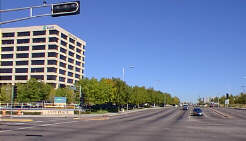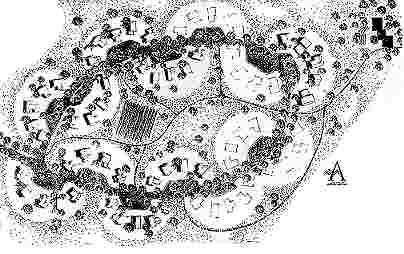A well-designed environment often resonates in people; their physical, social/cultural, visual, emotional, and spiritual needs seem to find satisfaction. A well-designed environment should give people using it a sense of comfort, identity and joy and must be accessible to all. Allen Jacobs and Donald Appleyard in an article written in 1987 said, "Good urban design must be for the poor as well as for the Rich". The Albuquerque Museum/Old Town, Park Square mixed-use complex in Uptown, Albuquerque High School and Central Avenue Streetscape in Downtown, the senior citizen residential complex in Barelas, and the La Luz townhouses along North Coors Road are local examples of good urban design. They relate well to people and their activity needs, the street, and the existing environment, both built and natural.
 |
Old Town: Old Town, built in the early 1700s, was once the center of Albuquerque. Today it is a historic district and tourist attraction. The San Felipe Catholic church, various shops, and restaurants surround the original plaza. More shops and restaurants cluster around other small courtyards off of San Felipe and Romero Streets. A portal--a covered passage in front of shops--and the many narrow streets give the area a pleasant, pedestrian ambience. There is easy access by automobile, bus, and foot from Central Avenue and Rio Grande Boulevard. The area has charm, history and financial success.
Albuquerque Museum: The museum was built on the edge of Old Town in the late 1970s and is accessible from I-40 via Rio Grande Boulevard and Mountain Road. Entrances from 19th Street and the beautifully landscaped Tiguex Park provide the museum with a very attractive setting. The museum is accessible from Old Town Plaza through two courtyards, and public and private parking are provided between the Plaza and the museum. The area serves well a variety of users, including museum goers, shoppers, and tourists.
Park Square, Uptown: Park Square is a mixed-use development of retail, office, and parking structures. The buildings' configuration and design create courtyards and pedestrian movement separate from that of automobiles. The tree-shaded plaza has benches for employees and shoppers. A pedestrian path connects the office plaza to shops, a portal in front of the shops, landscaped parking, and pastel colors on buildings enhance the environment and give it an appealing sense of place.
 |
Old Albuquerque High School: The former glory of the old Albuquerque High School can be seen today even through its vandalized windows. The buildings in this complex were built at different times between 1914 and 1940. The height and shape of the buildings vary according to their functions, yet there is a continuity of style and use of building materials. The buildings are built around a courtyard that allowed students to walk safely from one building to the other. The building still has considerable re-use potential if preserved before further deterioration.
Downtown Central Avenue Streetscape: The city revitalized Central Avenue from Second to Eighth Street in 1994. The sidewalks have been widened to accommodate pedestrian-scale street lighting, trees, benches and other street furniture, and fewer signs. The impact of this project has resulted in adjacent property owners' improvement of their properties and increased pedestrian activity.
Neighborhood Parks: Albuquerque has a good system of neighborhood parks, good both in number and quality, especially in the older neighborhoods. The neighborhood parks, of various sizes, are often located in the middle of residential neighborhoods and provide both visual relief and a place of recreation. With their benches, shade trees, sidewalks, and play equipment, the parks are urban oases. The city and neighborhood associations host public events, such as Arts in the Parks. A program of combining a public park with an elementary school play ground is being implemented in the Princess Jeanne neighborhood.
In contrast to the above examples, there are metal benches in parks and at shadeless bus stops, where people wait in the sun with a temperatures over 100 degrees. Clearly the design neglected the comfort of the user.
 |
The Uptown area has two regional shopping malls located diagonally across each other along Louisiana Boulevard, and each mall has food courts and restaurants. The office employees in the several multistory office buildings nearby must--if they want to go for lunch at either mall--cross eight to ten lanes of traffic on Louisiana, with a narrow median and a very brief crossing signal. Otherwise, these employees are forced to drive their automobiles that short distance. Although the design of Park Square, located in Uptown area, is successful, the urban design context of the larger area ignores comfort, safety and convenience of many of its users.
 |
The Coronado Mall has many entrances, yet from a distance they are not identifiable. Large parking lots surround the Winrock and Coronado shopping malls and offer no shaded walkways. People may have to walk as far as 1/8 of a mile in scorching heat. All over the country, shopping malls are built on the same design, irrespective of climate or other environmental factors.
The transportation engineer's primary goal in designing city streets is to move vehicular traffic as efficiently as possible. Tree plantings along streets provide enclosure and shade. The sense of enclosure causes the driver to drive slower and more cautiously. The traffic engineer, however, sees such plantings as a traffic impediment and sometimes even a liability. Yet without the trees, wide roads encourage drivers to ignore speed limits.
 |
Food, shelter, clothing, and play are some of the basic needs of human beings. These needs translate into land uses--residential, commercial, educational, and recreational. The design and planning principles that must be considered in the development of an environment are as follows:
All the implications of the above principles must be considered and a sequence followed. One such consideration is the climatic factor. Failing to consider climate can increase operating costs of the project; for example, if very large windows are placed on the southwest side, the inside of the building will accumulate heat, resulting in excessive cooling needs. Similarly, if heavy industrial development is located near a residential area, the residential property may not sell, and if it does, there may be health hazards. Retrofitting to correct problems always has a higher cost. Here are the steps that should be followed in the design process.
 |
The creation of well-designed environments requires input, coordination and cooperation of many groups - employees, business owners, developers, shoppers, various agencies and departments, public officials, and the general public. The development of plans, policies, urban design guidelines and standards - and a strong commitment to enforcing them - are all equally important. These tools help guide development and protect special environments, both natural and built (historical districts, for instance). Examples of general subdivision guidelines follow.
(Up to Section II, Back to Walking in the Built Environment, On to Climate in the Built Environment)